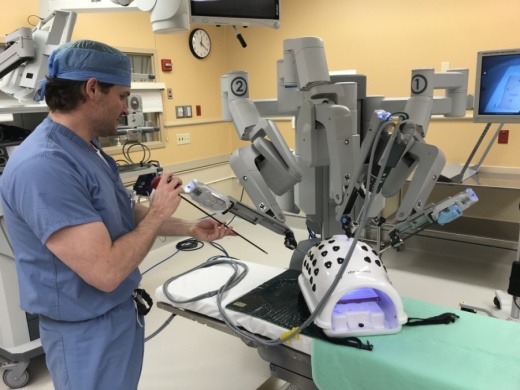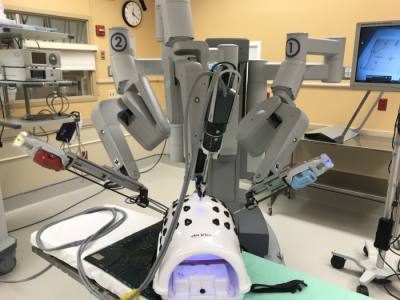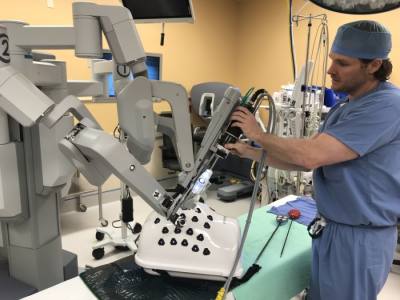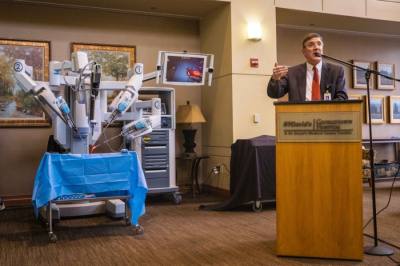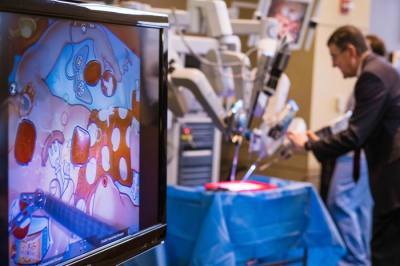Earlier this year, St. David’s Georgetown Hospital purchased a $2 million robot to assist with minimally invasive surgeries.
The device includes multiple arms attached to a console that interacts with the patient as the surgeon operates it nearby.
According to Dr. Wade Dunlap, a general surgeon at St. David’s Georgetown, using the robot results in smaller incisions, decreased time at the hospital, faster recovery and less pain medication.
“I do inguinal hernias using the robot, and even laparoscopically patients would have a fair bit of pain afterwards and require narcotic prescriptions,” Dunlap said. “At this point in my robotics practice, 95% of patients are discharged with no opioids or narcotic prescriptions. They’re maintained on Tylenol or Advil and sometimes not even that.”
The acquisition of the robot speaks to St. David’s commitment to advancing and offering a full range of technology, Dunlap said.
“There’s always been evolution in surgery,” he said. “In the beginning you just made an incision as big as you needed to get your hands in and do what you needed to do to fix the problem. And then, there was the advent of laparoscopy, where you used small incisions and cameras and scopes in order to have less impact on the patient. This robotic technology is just the next evolution, where you can make smaller incisions and work in tighter spaces more easily.”
Almost anything that can be done laparoscopically can be done with the robot, Dunlap said, including gall bladder, hernia, colon and other bowel surgeries; gastric and bariatric surgeries and more, but with a faster recovery time.
The robot is also more ergonomic to operate and does not require the surgeon to lean over like in traditional surgery, which can result in chronic neck and back pain.
“It could certainly extend surgeon and physician operating careers, which is a secondary benefit to patients,” Dunlap said.
St. David’s Georgetown CEO Hugh Brown said the hospital anticipates the addition of the robot will attract more surgeons to the community.
“These doctors are calling and saying, ‘We would like to come to Georgetown now that you’re able to allow us to use the tools that we feel are in our patients' best interest,’” he said.
Brown said the hospital still maintains all other surgical options along with the addition of the robot.
“This is the leading-edge technology, but it’s not appropriate for every case,” he said. “I do think it will enhance the ability for more patients to not have to travel to other facilities—now, they can stay right here in Georgetown.”
After postponing due to coronavirus, the hospital resumed surgeries and robotic procedures April 27. Additional precautions are being taken, including the following.
- Screening processes, including temperature checks, are in place for all patients, visitors and clinicians before they enter facilities.
- Universal masking is required throughout facilities, which exceeds CDC guidelines;
- Each facility has a separate location for COVID-19-positive patients and those who are under investigation. These patients are masked and escorted to designated locations.
- Heightened infection prevention policies are in use, including the removal or frequent cleaning of high-touch items.
- Non-COVID-19 patients as well as those receiving outpatient care or patients with scheduled procedures are treated in separate areas and assigned caregivers who are not concurrently caring for COVID-19-positive patients.
- All patients are tested for COVID-19 prior to their surgery or procedure.
- Updated visitor policies, including limitations, which have been in place for the duration of the pandemic, remain in place across facilities.
“We continue to have adequate supplies of personal protective equipment for patients, clinicians, caregivers, staff and visitors,” Brown said. “While many of us are concerned about the pandemic, it should not prevent us from seeking medical treatment, as our hospitals are among the safest places to be during this time.”




